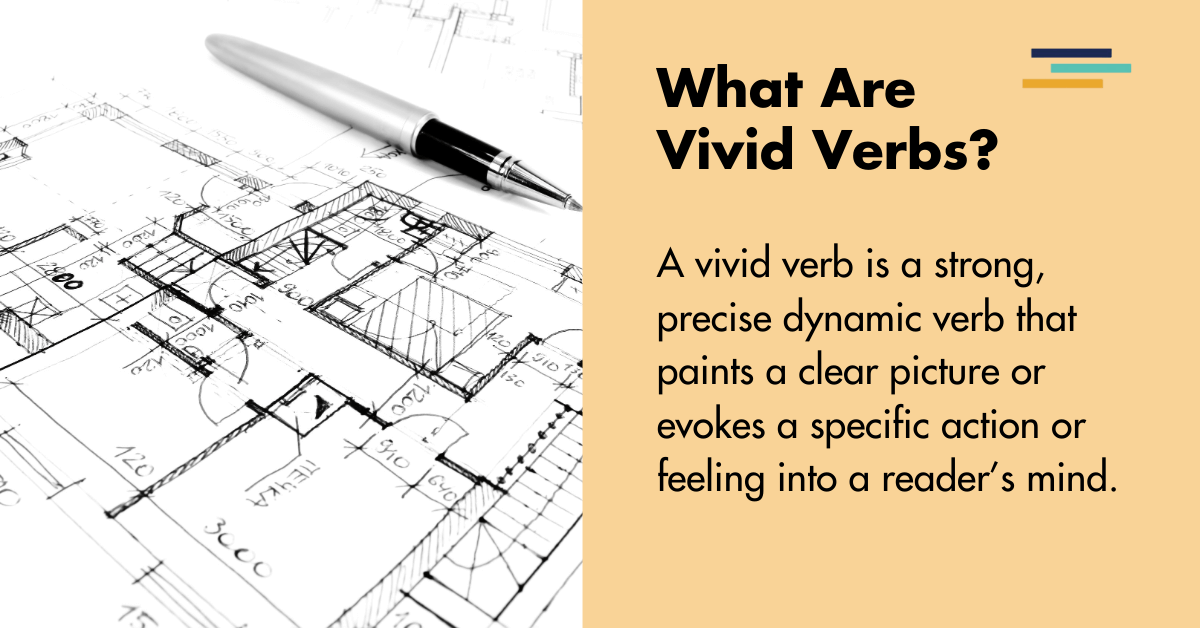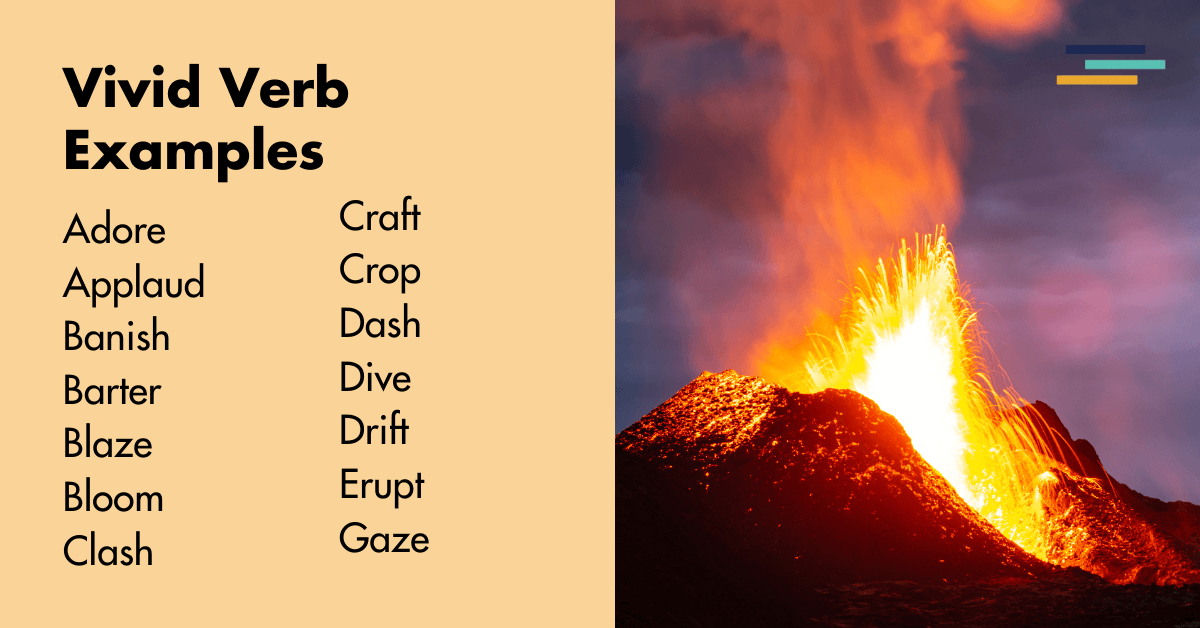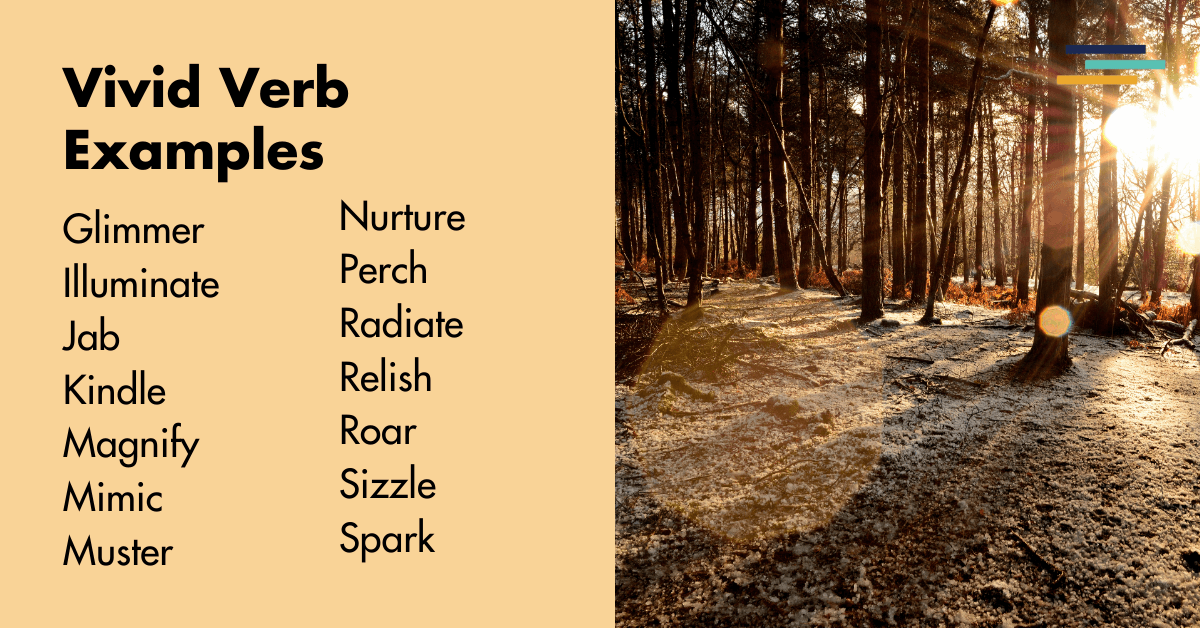
Writing a well-crafted sentence is like throwing a party hosted by the four major classes of English words—nouns, adjectives, adverbs, and verbs.
Nouns and adjectives attend to guests and mingle among them. Their faces crack smiles when they must, or display empathy when summoned.
Adverbs snub their noses at such grace. They clamor for attention under the guise of their deserving life-of-the-party status.
The fourth class, verbs, detest the haughtiness of adverbs; unless, of course, the static or lazy nature of those verbs allows adverbs to have their way. Verbs of a different nature aspire to remain true to their calling. They ignite enthusiasm among partygoers, and among the other hosts as well. The more vivid verbs electrify the sparks and surge the party’s energy to the delight of everyone.
What’s a Vivid Verb?
A vivid verb is a strong, precise dynamic verb that paints a clear picture or evokes a specific action or feeling into a reader’s mind.
Let’s delve deeper into the definition.
Verbs fall into one of two classes, depending on how they function in a sentence: finite verbs and non-finite verbs.
Finite verbs function like main characters; non-finite verbs, like supporting characters. Each of the two classes breaks down further into static or dynamic. Static verbs show stasis or state of being. Dynamic verbs display action and emotion. They convey sensuality. They show tension and suspense, and build unique story worlds.
Static verbs fall into one of three sub-categories: linking (most forms of being), helping (used to conjugate tenses), and causative (an action required to cause another).
Dynamic verbs don’t slide into such neat sub-categories. They land on continuums running from weak to strong, or from vague to precise. Vivid verbs settle onto the strong side of these continuums.
For instance, I employed four finite verbs in the three previous sentences: fall, slide, land, and settle. I enlisted these as dynamic stand-ins for the notion of how verbs “fit” into certain categories. The words “fall,” “slide,” “land,” and “settle” evoke powerful and specific images.

The Benefit of Using Vivid Verbs
The first drafts of our writing seldom drip like honey with vivid verbs. Honey commands more effort than that. First drafts are like the nectar forager bees harvest from flowers. Once loaded, forager bees buzz back to their hive, where they dance their way through the hustle and bustle of other worker bees. These worker bees lap up the partially digested nectar that forager bees regurgitate for them. The process repeats from worker bee to worker bee until the hexagonal cells of the hive’s honeycomb swell with vivid verbs—I mean, with honey.
Vivid verbs are to those less powerful what honey is to nectar. They reward the effort poured into the process of foraging for them when they’re still in the raw, and then digesting them, and then switching them around (analogous, I suppose, to regurgitating them); until they transform into the delicious and energizing honey of just the right vivid verb.
Vivid verbs ignite enthusiasm in our readers. They electrify the sparks. And they surge forward the energy of the stories we tell—whether we intend for that energy to convey joy and excitement, tension and conflict, or a devastating heartbreak.
Vivid Verb Example Sentences
George Orwell’s Animal Farm oozes with vivid verbs. Here’s a snippet of five sentences from near the end of Chapter II:
- “A little way down the pasture, there was a knoll that commanded a view of most of the farm. The animals rushed to the top of it and gazed round them in the clear morning light. Yes, it was theirs—everything that they could see was theirs! In the ecstasy of that thought, they gambolled round and round, they hurled themselves into the air in great leaps of excitement. They rolled in the dew, they cropped mouthfuls of the sweet summer grass, they kicked up clods of the black earth and snuffed its rich scent.”
I boldfaced the thirteen verbs in this selection. Only two are non-finite; the rest are finite. Only two are static (was). Of the remaining nine, eight are vivid verbs (rushed, gazed, gambolled, hurled, rolled, cropped, kicked, and snuffed).
I included this example for two reasons. First, because it shows the effort Orwell put into selecting vivid verbs to enliven and energize his story. Look again at the eight vivid verbs. Orwell could have settled for much weaker alternatives, some or all of which likely found their way into his first draft of this scene. Thankfully, he didn’t settle for nectar, but labored on for the honey.
Second, the example also models Orwell’s strategic use of static verbs. We may not prioritize their role in the party; but that doesn’t require we disinvite them and never allow them in.
Here are a few other examples of turning the nectar of weak or static verbs into vivid verbs:
- Instead of saying “ran fast,” you might use “dash.” As in, “She dashed to catch the bus.”
- Instead of “look at,” you could use “gaze.” As in, “He gazed at the stars.”
- Instead of “make,” you might use “engineer.” “Some worker bees engineer the hive; others forage for nectar.”
- Instead of “eat,” you could use “devour.” As in, “He devoured the hot dog in a single bite.”
- Instead of “is happy,” you could write “glows.” As in, “She glows every time she sees her granddaughter skipping toward her in the park.”
- Instead of “is noisy,” you could write “clatters.” As in, “The dishwasher clatters more when it first starts the wash cycle.”
- Instead of “use” (as appears in the title of this post), you could write, “wield.” As in, “Vivid Verbs and How to Wield Them With Impact.”

List of Vivid Verbs
Here is an expanded list of 153 vivid verbs in alphabetical order:
- Abduct
- Accelerate
- Achieve
- Adore
- Ambush
- Amplify
- Analyze
- Annihilate
- Applaud
- Ascend
- Ascertain
- Assert
- Astonish
- Attack
- Banish
- Barter
- Batter
- Bash
- Beckon
- Blaze
- Blare
- Bloom
- Bolster
- Breeze
- Bristle
- Burst
- Burrow
- Captivate
- Carve
- Charge
- Chase
- Clamber
- Clash
- Clench
- Clutch
- Command
- Conquer
- Craft
- Crave
- Crawl
- Crop
- Dash
- Decline
- Deflect
- Demolish
- Devastate
- Devour
- Dive
- Drift
- Dwindle
- Embark
- Emerge
- Embrace
- Engineer
- Engulf
- Erupt
- Evaporate
- Exclaim
- Expand
- Explode
- Flee
- Flourish
- Flutter
- Forge
- Gambol
- Garner
- Gasp
- Gaze
- Glimmer
- Grasp
- Grip
- Gush
- Harness
- Hurl
- Illuminate
- Immerse

- Implode
- Incite
- Inspire
- Jab
- Jolt
- Juggle
- Kindle
- Leap
- Loom
- Lure
- Magnify
- Maneuver
- Manipulate
- Mesmerize
- Mimic
- Muster
- Nestle
- Nurture
- Obliterate
- Overcome
- Overwhelm
- Pelt
- Perch
- Plunge
- Pounce
- Propel
- Pry
- Quake
- Quench
- Radiate
- Ravage
- Reclaim
- Relish
- Revamp
- Revitalize
- Roam
- Roar
- Savor
- Scatter
- Scorch
- Shatter
- Shiver
- Shriek
- Sizzle
- Slink
- Slither
- Snuff
- Soar
- Soothe
- Spark
- Sprint
- Squash
- Stagger
- Storm
- Strive
- Surge
- Sweep
- Thrive
- Trample
- Tremble
- Unleash
- Unravel
- Uproot
- Vanish
- Venture
- Wade
- Wander
- Weave
- Whisk
- Wield
- Wither
- Wobble
- Wrangle
- Wrestle
- Yank
- Yearn
- Zap
- Zoom
Tips For Using Vivid Verbs
Mark each verb in the first draft of a scene you’ve written. Then, categorize each verb as either static or dynamic.
Replace static verbs with dynamic verbs. Don’t worry yet about how vivid your replacements are. We’ll inspect for that next. In addition, force yourself to defend any choices to retain static verbs. Pretend you’re George Orwell and name that strategic purpose.
Finally, review your list of dynamic verbs and evaluate their relative strength and precision. Select the vivid verb that best matches your intentions to show:
- characterization and character actions
- mood setting
- tension
- relationship subtexts
- sensory details
- pacing.
Replace weak and imprecise dynamic verbs with stronger and more precise dynamic verbs. Consult a list like the one in this article for ideas.
Have fun and go crazy storming the world with vivid verbs!


